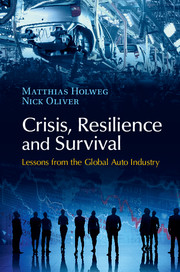Book contents
- Frontmatter
- Dedication
- Contents
- List of figures
- List of tables
- Acknowledgements
- 1 Why a book on corporate resilience?
- 2 The evolution of a global industry
- 3 Competing in a global industry
- 4 Concepts: Stakeholders, operations and context
- 5 Rover: Inside a failing car company
- 6 The failure of Saab Automobile
- 7 Near misses: Chrysler and Nissan
- 8 The future shape of the industry
- Appendix
- Notes
- Bibliography
- Secondary data sources
- Index
2 - The evolution of a global industry
Published online by Cambridge University Press: 05 December 2015
- Frontmatter
- Dedication
- Contents
- List of figures
- List of tables
- Acknowledgements
- 1 Why a book on corporate resilience?
- 2 The evolution of a global industry
- 3 Competing in a global industry
- 4 Concepts: Stakeholders, operations and context
- 5 Rover: Inside a failing car company
- 6 The failure of Saab Automobile
- 7 Near misses: Chrysler and Nissan
- 8 The future shape of the industry
- Appendix
- Notes
- Bibliography
- Secondary data sources
- Index
Summary
Few inventions have shaped our lives as much as the automobile. It not only allows us to freely move around in our personal lives, it also underpins and enables much of our economic activity by being able to efficiently move goods. As we write this book, the global automotive industry has produced a combined 3 billion vehicles since 1900. The annual growth rate of industry output since 1945 has been 6.3 per cent, and this growth – despite distinct troughs during economic crises – has accelerated in the most recent decade.
In 2013 a total of 87,354,003 vehicles were produced globally, of which 65,462,496 were passenger cars. These added to the 1.1 billion vehicles presently in operation on the planet (see Figures 2.1 and 2.2).
The global auto industry comprises around 40 companies (or groups of companies) who in 2014 each manufactured 100,000 cars a year or more. Most of these also produce light commercial vehicles and about half have divisions that produce heavy commercial vehicles. The largest of these are truly colossal – companies such as Toyota, GM and Volkswagen produce around 10 million vehicles a year, employ hundreds of thousands of people in 100s of assembly plants and other facilities around the world. Yet, despite this scale, giant car companies are not immune from failure, as the bankruptcies of both GM and Chrysler in 2009 show.
In this chapter we will describe the evolution of the auto industry, as well as the operation of car companies within it and look at their strategy and operations. Car companies represent an extreme in terms of scale and complexity, but we will argue that many of the processes at work in the auto industry are common to many other organizations – they are simply played out on a much greater scale. The auto industry also has six key idiosyncrasies that are key to understanding both the dynamics of the industry and the success and failure of particular auto firms. These are:
Persistent global production overcapacity – in aggregate, automakers around the world have the capacity to produce far more vehicles than there is demand for. This is not a transient problem – overcapacity has existed for many years.
Auto firms have national and corporate symbolic value – for developing economies, possession of a car industry symbolizes economic development and progress.
- Type
- Chapter
- Information
- Crisis, Resilience and SurvivalLessons from the Global Auto Industry, pp. 8 - 50Publisher: Cambridge University PressPrint publication year: 2015



